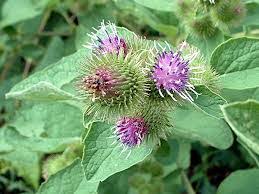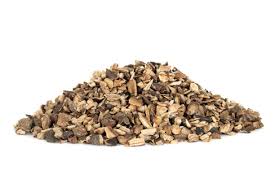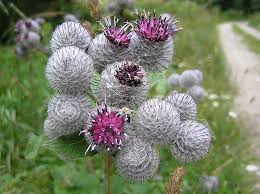
Arctium lappa, commonly called greater burdock, gobō, edible burdock, lappa, beggar's buttons, thorny burr, or happy major is a Eurasian species of plants in the family Asteraceae, cultivated in gardens for its root used as a vegetable. Greater burdock is a biennial plant, rather tall, reaching as much as 3 metres (10 feet).
This species is native to the temperate regions of the Old World,from Scandinavia to the Mediterranean, and fromthe British Isles through Russia, and the Middle East to India, China, Taiwan and Japan. It is naturalized almost everywhere and is usually found in disturbed areas, especially in soil rich in humus and nitrogen, preferring full sunlight. The species is commonly cultivated in Japan.



Medicinal uses
Arctium lappa, commonly known as burdock, has various medicinal uses, including:
Always consult with a healthcare professional before using herbal remedies for medicinal purposes.
Precautions
When using Arctium lappa (burdock), consider the following precautions:
Always consult with a healthcare provider bef or e starting any new herbal supplement.
Interactions
When using Arctium lappa (burdock), be aware of potential interactions:
Always consult a healthcare provider before combining burdock with any medications or supplements.
Culinary uses
Arctium lappa (burdock) has several culinary uses:
Always ensure the burdock is properly identified and prepared before consumption.
The roots are edible cooked. Greater burdock root is known as niúbàng (牛蒡) in Chinese, which was borrowedintoJapanese as gobō and Korean as ueong (우엉), and is widely eaten in Japan, Korea and Taiwan. It was used in Europe during the Middle Ages as a vegetable, but now it is rarely used except in Italy and Portugal, where it is known as bardana or "garduna". It is also known under the same names and eaten in Brazil. Plants are cultivated for their slender roots, which can grow about 1 m long and 2 centimetres (3⁄4 in) across. The root was traditionally used in Britain as a flavouring in the herbal drink dandelion and burdock, which is still commercially produced
The root is very crisp and has a sweet, mild, and pungent flavor with a little muddy harshness that can be reduced by soaking julienned/shredded roots in water for five to ten minutes. The harshness shows excellent harmonization with pork in miso soup (tonjiru) and takikomi gohan (a Japanese-style pilaf). A popular Japanese dish is kinpira gobō, julienned or shredded burdock root and carrot, braised with soy sauce, sugar, mirin and/or sake, and sesame oil. Another is burdock makizushi, rolled sushi filled with pickled burdock root; the burdock root is often artificially colored orange to resemble a carrot. Burdock root can also be found as a fried snack food similar in taste and texture to potato chips and is occasionally used as an ingredient in tempura dishes. Fermentation of the root by Aspergillus oryzae is also used for making miso and rice wine in Japanese cuisine. The tender leaf stalks can be peeled and eaten raw or cooked. Immature flower stalks may also be harvested in late spring, before flowers appear. The taste resembles that of artichoke, a burdock relative.

Address: B23-2, Khayam Complex, Hormozan St., Phase 2, Sanat Sq., Tehran, Iran
Tel: +98 21 88 08 77 01
Mobile: +98 912 502 51 47
All services and products of this site, as the case may be, have the necessary licenses from the relevant authorities and the activities of this site are subject to the laws and regulations of the Islamic Republic of Iran


